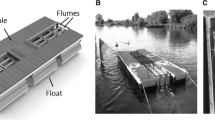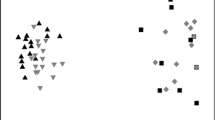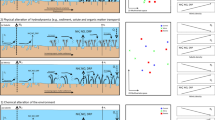Abstract
Introduced ecosystem engineers can severely modify the functioning on invaded systems. Species-level effects on ecosystem functioning (EF) are context dependent, but the effects of introduced ecosystem engineers are frequently assessed through single-location studies. The present work aimed to identify sources of context-dependence that can regulate the impacts of invasive ecosystem engineers on ecosystem functioning. As model systems, four locations where the bivalve Ruditapes philippinarum (Adams and Reeve) has been introduced were investigated, providing variability in habitat characteristics and community composition. As a measure of ecosystem engineering, the relative contribution of this species to community bioturbation potential was quantified at each site. The relevance of bioturbation to the local establishment of the mixing depth of marine sediments (used as a proxy for EF) was quantified in order to determine the potential for impact of the introduced species at each site. We found that R. philippinarum is one of the most important bioturbators within analysed communities, but the relative importance of this contribution at the community level depended on local species composition. The net contribution of bioturbation to the establishment of sediment mixing depths varied across sites depending on the presence of structuring vegetation, sediment granulometry and compaction. The effects of vegetation on sediment mixing were previously unreported. These findings indicate that the species composition of invaded communities, and the habitat characteristics of invaded systems, are important modulators of the impacts of introduced species on ecosystem functioning. A framework that encompasses these aspects for the prediction of the functional impacts of invasive ecosystem engineers is suggested, supporting a multi-site approach to invasive ecology studies concerned with ecosystem functioning.


Similar content being viewed by others
References
Aller RC (1982) The effects of macrobenthos on chemical properties of marine sediment and overlying water. In: McCall PL (ed) Animal-sediment relations. The biogenic alteration of sediments. Plenum Press, New York, pp 53–102
Antoniadou C, Chintiroglou C (2006) Trophic relationships of polychaetes associated with different algal growth forms. Helgoland Mar Res 60:39–49
Aspden RJ, Vardy S, Perkins RG et al (2004) The effects of clam fishing on the properties of surface sediments in the Lagoon of Venice, Italy. Hydrol Earth Syst Sci 8:160–169
Atkinson RJA, Naylor E (1973) Activity rhythms in some burrowing decapods. Helgolander wiss Meeresunters 24:192–201
Badino G, Bona F, Maffiotti A et al (2004) Impact of mechanical clam harvesting on a benthic habitat: evaluation by means of sediment profile imaging. Aquat Conserv 14:S59–S67
Biles CL, Paterson DM, Ford RB et al (2002) Bioturbation, ecosystem functioning and community structure. Hydrol Earth Syst Sci 6:999–1005
Blanchet H, de Montaudouin X, Lucas A et al (2004) Heterogeneity of macrozoobenthic assemblages within a Zostera Noltii Seagrass Bed: diversity, abundance, biomass and structuring factors. Estuar Coast Shelf S 61:111–123
Borum J, Sand-Jensen K, Binzer T et al (2006) Oxygen movement in seagrasses. In: Larkum AWD, Orth RJ (Ed) Seagrasses: biology, ecology, and conservation. Springer, Netherlands, pp 255–270
Bouma TJ, Olenin S, Reise K et al (2009) Ecosystem engineering and biodiversity in coastal sediments: posing hypothesis. Helgol Mar Res 63:95–106
Bousfield EL (1970) Adaptive radiation in sand-burrowing amphipod crustaceans. Chesap Sci 11:143–154
Brey T (2001). In: Population dynamics in benthic invertebrates. A virtual handbook. Wegener Institute for Polar and Marine Research, Germany. http://www.Awi-Bremerhaven.De/Benthic/Ecosystem/Foodweb/Handbook/Main.Html.Alfred
Cade BS, Noon BR (2003) A gentle introduction to quantile regression for ecologists. Front Ecol Environ 1:412–420
Cade BS, Noon BR, Flather CH (2005) Quantile regression reveals hidden bias and uncertainty in habitat models. Ecology 86:786–800
Cadee GC (2000) Sediment dynamics by bioturbating organisms. In: Reise K (ed) Ecological comparisons of sedimentary shores. Springer, Berlin, pp 127–148
Caldow RWG, Stillman RA, Durell SEAlVd et al (2007) Benefits to shorebirds from invasion of a non-native shellfish. Proc R Soc Lond B Biol Sci 274:1449–1455
Campos CJA, Cachola RA (2006) The introduction of the Japanese carpet shell in coastal lagoon systems of the Algarve (South Portugal): a food safety concern. Internet J Food Saf V:1–2
Cardinale BJ, Nelson K, Palmer MA (2000) Linking species diversity to the functioning of ecosystems: on the importance of environmental context. Oikos 91:175–183
Clavier J (1984) Production due to regenaration by Euclymene Oerstedi (Clapadde) (Polychaeta: Maldanidae) in the Maritime Basin of the Rance (Northern Britanny). J Exp Mar Biol Ecol 75:97–106
Colautti RI, MacIsaac HJ (2004) A neutral terminology to define ‘invasive’ species. Divers Distrib 10:135–141
Coyle KO, Highsmith RC (1994) Benthic amphipod community in the Northern Bering Sea: analysis of potential structuring mechanisms. Mar Ecol-Prog Ser 107:233–244
Crooks JA (1996) The population ecology of an exotic mussel, Musculista Senhousia, in a Southern California Bay. Estuaries 19:42–50
Crooks JA (2002) Characterizing ecosystem-level consequences of biological invasions: the role of ecosystem engineers. Oikos 97:153–166
Cuddington K, Hastings A (2004) Invasive engineers. Ecol Modell 178:335–347
D’Andrea AF, Lopez GR (1997) Benthic macrofauna in a shallow water carbonate sediment: major bioturbators at the Dry Tortugas. Geo-Marine Lett 17:276–282
Dauer DM (1983) Functional morphology and feeding Behavior of Scolelepis Squamata (Polychaeta: Spionidae). Mar Biol 77:279–285
Davie JT (1993) Macrofaunal community bioturbation along an estuarine gradient. Aqua Ecol 27:147–153
Drew GA (1907) The habits and movements of the razor-shell clam, Ensis Directus, Con. Biol Bull 13:127–140
Emerson S, Jahnke R, Heggie D (1984) Sediment-water exchange in shalow estuarine sediments. J Mar Res 42:709–730
Evans FGC (1951) An analysis of the behaviour of Lepidochitona Cinereus in response to certain physical features of the environment. J Anim Ecol 20:1–10
Fauchald K, Jumars PA (1979) The diet of worms: a study of polychaet feeding guilds. Oceanogr Mar Biol Annu Rev 17:193–284
Fridley JD, Stachowicz JJ, Naeem S et al (2007) The invasion paradox: reconciling pattern and process in species invasions. Ecology 88:3–17
Gaudencio MJ, Cabral HN (2007) Trophic structure of macrobenthos in the Tagus Estuary and adjacent coastal shelf. Hydrobiologia 587:241–251
Gerino M, Frignani M, Munai C et al (2007) Bioturbation in the Venice Lagoon: rates and relationship to organisms. Acta Oecol Int J Ecol 32:14–25
Goulletquer P (2006). In: Ruditapes Philippinarum. FAO fisheries and aquaculture department. http://www.fao.org/fishery/culturedspecies/Ruditapes_philippinarum/en#tcBioFea. April
Hassack E, Holdich DM (1987) The tubicolous habit amongst the tanaidacea (Crustacea, Peracarida) with particular reference to deep-sea species. Zool Scipta 16:223–233
Hiddink JG (2005) Implications of Liebig’s law of the minimum for the use of ecological indicators based on abundance. Ecography 28:264–271
Huettel M, Webster IT (2001) Porewater flow in permeable sediments. In: Boudreau BP (ed) The benthic boundary layer. Transport processes and biogeochemistry. Oxford University Press, Oxford
Kabat AR (1990) Species of Naticidae (Mollusca, Gastropoda) described by Linnaeus in the Systema-Naturae (1758). Zool J Linn Soc-Lond 100:1–25
Kanaya G, Nobata E, Toya T et al (2005) Effects of different feeding habits of three bivalve species on sediment characteristics and benthic diatom abundance. Mar Ecol-Prog Ser 299:67–78
Kennedy JJ (1995) The courtship, pseudo-copulation behaviour and spermatophore of Turritella Communis Risso 1826 (Prosobranchia:Turritellidae). J Molluscan Stud 61:421–434
Koenker R, Bassett G (1978) Regression quantiles. Econometrica 46:33–50
Koenker R, Bassett G (1982) Robust-tests for heteroscedasticity based on regression quantiles. Econometrica 50:43–61
Koulouri P, Dounas C, Arvanitidis C et al (2006) Molluscan diversity along a mediterranean soft bottom sublittoral ecotone. Sci Mar 70:573–583
Laima M, Maksymowska-Brossard D, Sauriau PG et al (2002) Fluff deposition on intertidal sediments: effects on benthic biota, ammonium fluxes and nitrification rates. Biogeochemistry 61:115–133
Levine JM, D’Antonio CM (1999) Elton revisited: a review of evidence linking diversity and invasibility. Oikos 87:15–26
Maire O, Duchene JC, Rosenberg R et al (2006) Effects of food availability on sediment reworking in Abra Ovata and A. Nitida. Mar Ecol-Prog Ser 319:135–153
Maire O, Duchêne JC, Grémare A et al (2007) A comparison of sediment reworking rates by the surface deposit-feeding bivalve Abra Ovata during summertime and wintertime, with a comparison between two models of sediment reworking. J Exp Mar Biol Ecol 343:21–36
Malaquias MAE, Condinho S, Cervera JL et al (2004) Diet and feeding biology of haminoea orbygniana (Mollusca : Gastropoda: Cephalaspidea). J Mar Biol Ass UK 84:767–772
Marine Biological Association of the United Kingdom (2009) In: European register of marine species. http://www.marbef.org/data. May
Marsden ID, Bressington MJ (2009) Effects of macroalgal mats and hypoxia on burrowing depth of the New Zealand Cockle (Austrovenus Stutchburyi). Estuar Coast Shelf S 81:438–444
Mermillod-Blondin F, Rosenberg R (2006) Ecosystem engineering: the impact of bioturbationon biogeochemical processes in marine and freshwater benthic habitats. Aquat Sci 68:434–442
Mermillod-Blondin F, Rosenberg R, Francois-Carcaillet F et al (2004) Influence of bioturbation by three benthic infaunal species on microbial communities and biogeochemical processes in marine sediment. Aquat Microb Ecol 36:271–284
Michaud E, Desrosiers G, Mermillod-Blondin F et al (2005) The functional group approach to bioturbation: the effects of biodiffusers and gallery-diffusers of the macoma balthica community on sediment oxygen uptake. J Exp Mar Biol Ecol 326:77–88
Michaud E, Desrosiers G, Mermillod-Blondin F et al (2006) The functional group approach to bioturbation: Ii. The effects of the macoma balthica community on fluxes of nutrients and dissolved organic carbon across the sediment–water interface. J Exp Mar Biol Ecol 337:178–189
Morton B, Chiu ST (1990) The diet, prey size and consumption of Philine Orientalis (Opistobranchia: Philinidae) in Hong Kong. J Molluscan Stud 56
Murray JMH, Meadows A, Meadows PS (2002) Biogeomorphological implications of microscale interactions between sediment geotechnics and marine benthos: a review. Geomorphology 47:15–30
Olafsson EB, Persson LE (1986) Distribution, life-cycle and demography in a brackish water population of the isopod Cyathura-Carinata (Kroyer) (Crustacea). Est Coast Shelf Sci 23:673–687
Orvain F (2005) A model of sediment transport under the influence of surface bioturbation: generalisation to the facultative suspension-feeder Scrobicularia Plana. Mar Ecol-Prog Ser 43:43–56
Ouellette D, Desrosiers G, Gagne JP et al (2004) Effects of temperature on in vitro sediment reworking processes by a gallery biodiffusor, the polychaete Neanthes Virens. Mar Ecol-Prog Ser 266:185–193
Pernet B (2000) A scaleworm’s setal snorkel. Invertebr Biol 119:147–151
Pihl L, Magnusson G, Isaksson I et al (1996) Distribution and growth dynamics of ephemeral macroalgae in shallow bays on the Swedish West Coast. J Sea Res 35:169–180
Pischedda L, Poggiale JC, Cuny P et al (2008) Imaging oxygen distribution in marine sediments. The importance of bioturbation and sediment heterogeneity. Acta Biotheor 56:123–135
Powilleit M, Kitlar J, Graf G (1994) Particle and fluid bioturbation caused by the priapulid worm Halicryptus-Spinulosis (Seibold, V). Sarsia 79:109–117
Pranovi F, Franceschini G, Casale M et al (2006) An ecological imbalance induced by a non-native species: the manila clam in the Venice Lagoon. Biol Invasions 595–609
Przeslawski R, Zhu Q, Aller R (2009) Effects of abiotic stressors on infaunal burrowing and associated sediment characteristics. Mar Ecol-Prog Ser 392:33–42
Raffaelli D (1985) Functional feeding groups of some intertidal molluscs defined by gut content analysis. J Molluscan Stud 51:233–239
Rhoads DC, Cande S (1971) Sediment profile camera for in situ study of organism-sediment relations. Limnol Oceanogr 16:110–114
Richter R (1936) Marken und spruren im hunsriick-schiefer. Ii. Schichtung Und Grund-Leben. Senckenbergiana 18:215–244
Robert R, Trut G, Laborde JL (1993) Growth, reproduction and gross biochemical-composition of the manila clam Ruditapes-Philippinarum in the Bay of Arcachon, France. Mar Biol 116:291–299
Ruesink JL (2003) One fish, two fish, old fish, new fish: which invasions matter? In: Kareiva PM, Levin SA (ed) The importance of species: perspectives on expendabiltity and triage. Princeton University Press, Princeton, pp 161–178
Scaps P (1995) Intraspecific agonistic behaviour in the polychaete perinereis cultrifera (Grube). Vie Milieu 45:123–128
Schaffner LC, Boesch DF (1982) Spatial and temporal resource use by dominant benthic amphipoda (Ampeliscidae and Corophiidae) on the middle atlantic bight outer continental-shelf. Mar Ecol-Prog Ser 9:231–243
Sgro L, Mistri M, Widdows J (2005) Impact of the infaunal manila clam, Ruditapes Philippinarum, on sediment stability. Hydrobiologia 550:175–182
Shea K, Chesson P (2002) Community ecology theory as a framework for biological invasions. Trends Ecol Evol 17:170–176
Simmers J, Bush BMH (1983) Motor programme switching in the ventilatory system of Carcinus Maenas: the neuronal basis of bimodal scaphognathite beating. J Exp Biol 104:163–181
Solan M, Cardinale BJ, Downing AL et al (2004) Extinction and ecosystem function in the marine benthos. Science 306:1177–1180
Solan M, Batty P, Bulling MT et al (2008) How biodiversity affects ecosystem processes: implications for ecological revolutions and benthic ecosystem function. Aquat Biol 2:289–301
Tallmark B (1980) Population dynamics of Nassarius Reticulatus (Gastropoda, Prosobranchia) in Gullmar Fjord, Sweden. Mar Ecol Prog Ser 3:51–62
Teal LR, Parker R, Fones G et al (2009) Simultaneous determination of in situ vertical transitions of color, pore-water metals, and visualization of infaunal activity in marine sediments. Limnol Oceanogr 54:1801–1810
Turoboyski K (1973) Biology and ecology of the crab Rhithropanopeus Harrisii Ssp. Tridentatus. Mar Biol 23:303–313
Valavanis VD, Pierce GJ, Zuur AF et al (2008) Modelling of essential fish habitat based on remote sensing, spatial analysis and gis. Hydrobiologia 612:5–20
Vaughn CC, Spooner DE, Galbraith HS (2007) Context-dependent species identity effects within a functional group of filter-feeding bivalves. Ecology 88:1654–1662
Venables WN, Ripley BD (2002) Statistics complements to modern applied statistics with S. Springer, New York
Volkenborn N, Hedtkamp SIC, JEEv Beusekom et al (2007a) Effects of bioturbation and bioirrigation by lugworms (Arenicola Marina) on physical and chemical sediment properties and implications for intertidal habitat succession. Estuar Coast Shelf S 74:331–343
Volkenborn N, Polerecky L, Hedtkamp SIC et al (2007b) Bioturbation and bioirrigation extend the open exchange regions in permeable sediments. Limnol Oceanogr 52:1898–1909
Wlodarska-Kowalczuk M, Pearson TH (2004) Soft-bottom macrobenthic faunal associations and factors affecting species distributions in an Arctic Glacial Fjord (Kongsfjord, Spitsbergen). Polar Biol 27:155–167
Acknowledgments
This project was funded by the Foundation for Science and Technology (Ministry of Science, Technology and Higher Education, Portugal), under contract BD/SFRH/21338/2005. The authors thank Dr. Jean-Paul Dreno, Dr. Isabelle Auby and Dr. Martin Plús at the Institut Français de Recherche pour l’Exploitation de la Mer (Arcachon, France), Dr.Saša Raicevich and Dr. Otello Giovanardi at the Istituto Centrale per la Ricerca Acientifica e Tecnologica Applicata al Mare (Chioggia, Italy), and the Instituto para a Conservação da Natureza (Portugal), for all the kind work and facilities made available. The authors also thank Augusto da Paz at the Cooperativa de Viveiristas da Ria Formosa for support provided during field work in Portugal. Dr. Camille Saurel and Vasco Cândido are kindly thanked for all the help provided with field work. The authors thank Martin Solan, the editor and two anonymous referees for constructive comments on an earlier version of the manuscript.
Author information
Authors and Affiliations
Corresponding author
Appendices
Appendix
See Table 4.
Sediment profile image analysis: estimation of mixing depth
Each image was analysed as follows: (1) image was split into Red–Green–Blue layers, of which only the red layer was used subsequently, as it produced the best contrast between the oxidized and the reduced sediment fractions; (2) the sediment–water interface was eliminated from analysis by manually drawing a polygon over this area which was defined as background, (3) the picture was converted into a binary image (foregroung/background) using a pixel intensity threshold, such that the oxidized sediment layer is defined as foreground; (4) the area defined as foreground was measured and divided by the width of the picture to produce the mean depth of the Fe redox transition, i.e., mixing depth (cm). Differences in sediment colour between study-sites may affect the estimation of this parameter. For this reason, we developed a standardization procedure to define the threshold within each study-site that minimized mixing depth estimation errors within site, and made the data comparable between sites. The procedure consisted of the following for each dataset: (1) intensity threshold was defined manually for each picture to optimize the contrast between oxidized and reduced sediment fractions; (2) ten pictures were selected to cover the observed threshold range; (3) of those, five thresholds were selected to estimate mixing depth (as described) for each of the ten pictures, covering the observed threshold range, so that five estimates were obtained for each picture; (4) all threshold values were plotted against mixing depth estimates for each picture; (5) standard threshold intensity was defined, per area, within the range for which mixing depth estimates varied the least for the maximum number of pictures.
Rights and permissions
About this article
Cite this article
de Moura Queirós, A., Hiddink, J.G., Johnson, G. et al. Context dependence of marine ecosystem engineer invasion impacts on benthic ecosystem functioning. Biol Invasions 13, 1059–1075 (2011). https://doi.org/10.1007/s10530-011-9948-3
Received:
Accepted:
Published:
Issue Date:
DOI: https://doi.org/10.1007/s10530-011-9948-3




